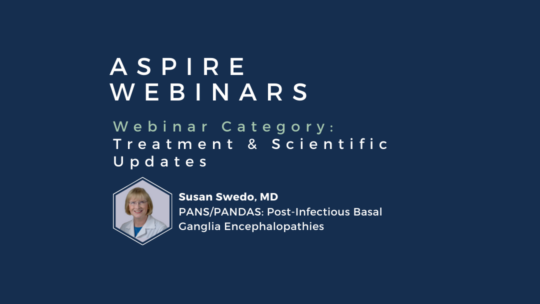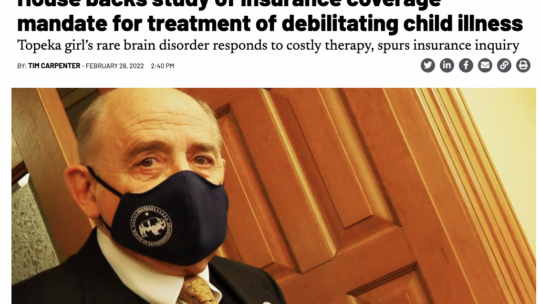
Webinar – Nancy O’Hara, MD, MPH, FAAP
Lecturer: Nancy O’Hara, MD, MPH, FAAP Webinar: Demystifying PANS/PANDAS: A Functional Medicine Guide on Basal Ganglia Encephalitis Date/Time: Monday, May 2nd – 4:00 PM EST Register for this...

Lecturer: Nancy O’Hara, MD, MPH, FAAP Webinar: Demystifying PANS/PANDAS: A Functional Medicine Guide on Basal Ganglia Encephalitis Date/Time: Monday, May 2nd – 4:00 PM EST Register for this...
“Neuropsychiatric disorders are common in children with bowel and bladder dysfunction (BBD), a syndrome associated with urinary frequency, urgency, holding, incontinence, and constipation. We evaluated BBD symptom severity in children and youth attending a tertiary care obsessive-compulsive disorder (OCD) clinic….. BBD symptoms are common and associated with high OCD-related impairment and psychiatric comorbidities. Standardized assessment may facilitate identification of BBD symptoms in this population and is critical to mitigating long-term physical and mental health impacts. Further studies are required to assess the relationship between BBD and OCD treatment outcomes.”
Reader Response: Lack of Association of Group A Streptococcal Infections and Onset of Tics
“Schrag et al. reported that Group A streptococcal (GAS) exposure is unrelated to tics in children at risk for tic disorders.1 The critical limitations of this study are that only children with genetic risks for tics were studied and information about risk for autoimmunity, infection susceptibility, and antibiotics use are absent.1 The EMTICS home page states that many patients refused to participate when told that antibiotic use would be limited. This would introduce a negative selection bias against families who perceive themselves as high risk and patients procuring antibiotics outside the trial.2“
In response to:

Speaker: Jennifer Leiman, MS, OTR/L Webinar: Executive Function Tools: Before, During, & After a PANS PANDAS Flare View this webinar: Executive Functioning Webinar Abstract: Connecting...
An investigational drug that blocks the dopamine-1 (D1) receptor reduces tics and is safe and well tolerated in children with Tourette syndrome (TS), a new study shows.
Importantly, unlike current medications for the disorder, ecocipam does not lead to weight gain, anxiety, depression, or tardive dyskinesia compared to placebo ― a factor that may lead to better adherence.

Lecturer: Susan Swedo, MD Webinar: PANS and PANDAS Recognition, Diagnosis and Treatment of Acute-onset Neuropsychiatric Symptoms Date/Time: Thursday, March 24 To Watch Webinar: Please fill out the...

TOPEKA — Shannon Wright’s daughter suddenly exhibited bizarre behavior Sept. 13, 2011, that was subsequently found to be a rare autoimmune disorder in which streptococcal or other infectious...
Pedijatrijsko autoimuno neuropsihijatrijsko oboljenje udruženo sa streptokokom
Pediatric Autoimmune Neuropsychiatric Disorder Associated with Streptococcal Infection
Jasmina Škorić1, Bojan Pavković1. 1 Dom zdravlja Dr Simo Milošević’, Beograd, Srbija
http://prevped.preventivnapedijatrija.rs/index.php/casopis/article/download/41/24
Conclusion: The patient showed signs of improvement after the intravenous administration of immunoglobulin which confirmed the underlying immunological aspect of the disease. Additionally, serologic test results that showed elevated antistreptolysin O titer and antideoxyribonuclease–B titer indicated streptococcal etiology. Precisely, these misdirected antibodies set off an inflammatory response that led to the basal ganglia damage resulting in behavioral changes, motor, cognitive and emotional disorders.
PANDAS in an Adult?: A Case Report. Deshmukh RP, Mane AB, Singh S.Ind J Priv Psychiatry 2022; 16 (1):44-45. DOI: 10.5005/jp-journals-10067-0104
“We report a case in order to suggest that we should be alert while assessing OCD in young patients, as it might be secondary to streptococcal infection. This has therapeutic implications. Trials of immunomodulator therapy can be given as suggested in a few kinds of literature. Although still experimental, it may have potential for the future, especially in those not responding to conventional treatment… This report might suggest that PANDAS-like syndrome may occur in adults also. We should be cautious of this syndrome during treatment.”
Neuroinflammation in a Rat Model of Tourette Syndrome, Zhongling Ke, Yanhui Chen, Guofeng Chen, Yanyan Liu, Neuroinflammation in a Rat Model of Tourette Syndrome, Frontiers in Behavioral Neuroscience, Vol 16, Front. Behav. Neurosci., 10 March 2022, DOI: 10.3389/fnbeh.2022.710116
Conclusion: The IDPN-induced TS rats had significant neuroinflammation in the brain, and the interaction between dopamine (DA) dysregulation and immune dysfunction may play a vital role in the pathogenic mechanisms of TS.
Bambauer R, Schiel R. Therapeutic Apheresis and Immunosuppression in Immunologic Diseases: A Review and OwnObservations. Clin Immunol Res. 2021; 5(2): 1-36. ISSN 2639-8486
“TA should be reserved for treatment of children and adolescents
who are severely affected by PANDAS. In such patients, it
appears to be safe, well-tolerated, and beneficial treatment
option [130]. Bien et al reported in 2020, besides the first-line
interventions of steroids, IVIG, and TA as second-line treatments
cyclophosphamide or rituximab [131].”